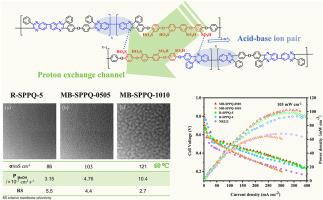Main-chain densely sulfonated poly(phenylquinoxaline) PEMs: Achieving high power density in DMFCs via microphase methodology
IF 9
1区 工程技术
Q1 ENGINEERING, CHEMICAL
引用次数: 0
Abstract
A series of sulfonic acid groups densely on main chain in random (R-SPPQs) and multiblock (MB-SPPQs) form polyphenylquinoline proton exchange membranes (PEMs) with acid-base ion crosslinking were synthesized. The relationship between membrane selectivity of proton conductivity (σ)/methanol permeability (PMeOH) and microstructure is investigated. R-SPPQs PEMs benefit from acid-base ion crosslinking. Ion exchange capacity (IEC) changing from 1.73 to 2.40 meq g−1, PMeOH increases from 1.89 × 10−7 to 3.15 × 10−7 cm2 s−1, approximately 1/10 that of NR212. R-SPPQ-5 shows the highest relative membrane selectivity (RS) of 5.5. Its maximum power density (Wmax) of 100 mW cm−2 exceeds that of NR212 (70 mW cm−2). Low repetitive structural units of MB-SPPQ-0505 with unconnected hydrophilic microphase-separation structure exhibit promoted σ of 103 mS cm−1 at 60 °C, outperforming R-SPPQ-4 with similar IEC by 45 %. The PMeOH value of 4.7 × 10−7 cm2 s−1 represents a 66 % increase over that of R-SPPQ-4, with a slight decrease in RS to 4.4. Its Wmax is 103 mW cm−2. This stems from the combination of low internal resistance and low PMeOH. There's no significant attenuation in battery performance in the 50-h durability test, indicating promising potential application prospects in direct methanol fuel cells. Increased repetitive structural units of MB-SPPQ-1010 with interconnected microphase-separated structure, resulting in a further 17 % increase in σ than MB-SPPQ-0505 at 60 °C. Whereas PMeOH is elevated to 10.4 × 10−7 cm2 s−1, resulting in a decrease in RS to 2.7. Its Wmax drops to 65 mW cm−2.

主链密集磺化聚(苯基喹啉)PEMs:通过微相方法在dmfc中实现高功率密度
通过酸碱离子交联,合成了主链上密集的随机磺酸基(R-SPPQs)和多嵌段磺酸基(MB-SPPQs)。研究了质子电导率(σ)/甲醇渗透率(PMeOH)的膜选择性与微观结构的关系。R-SPPQs PEMs受益于酸碱离子交联。离子交换容量(IEC)从1.73增加到2.40 meq g−1,PMeOH从1.89 × 10−7增加到3.15 × 10−7 cm2 s−1,约为NR212的1/10。R-SPPQ-5具有最高的相对膜选择性(RS),为5.5。其最大功率密度(Wmax)为100mw cm−2,超过了NR212的70mw cm−2。具有非连接亲水微相分离结构的MB-SPPQ-0505具有低重复结构单元,在60°C时的促进σ为103 mS cm−1,比具有类似IEC的R-SPPQ-4高45%。PMeOH值为4.7 × 10−7 cm2 s−1,比R-SPPQ-4增加了66%,RS略有下降,为4.4。其Wmax为103 mW cm−2。这源于低内阻和低PMeOH的结合。在50 h耐久性试验中,电池性能没有明显衰减,在直接甲醇燃料电池中有很好的应用前景。具有微相分离结构的MB-SPPQ-1010增加了重复结构单元,在60℃时σ比MB-SPPQ-0505增加了17%。而PMeOH升高到10.4 × 10−7 cm2 s−1,导致RS降低到2.7。其Wmax降至65mw cm−2。
本文章由计算机程序翻译,如有差异,请以英文原文为准。
求助全文
约1分钟内获得全文
求助全文
来源期刊

Journal of Membrane Science
工程技术-高分子科学
CiteScore
17.10
自引率
17.90%
发文量
1031
审稿时长
2.5 months
期刊介绍:
The Journal of Membrane Science is a publication that focuses on membrane systems and is aimed at academic and industrial chemists, chemical engineers, materials scientists, and membranologists. It publishes original research and reviews on various aspects of membrane transport, membrane formation/structure, fouling, module/process design, and processes/applications. The journal primarily focuses on the structure, function, and performance of non-biological membranes but also includes papers that relate to biological membranes. The Journal of Membrane Science publishes Full Text Papers, State-of-the-Art Reviews, Letters to the Editor, and Perspectives.
 求助内容:
求助内容: 应助结果提醒方式:
应助结果提醒方式:


